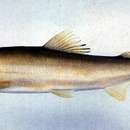Diagnostic Description
provided by Fishbase
Pyloric caeca 350-400.
- Recorder
- Estelita Emily Capuli
Diseases and Parasites
provided by Fishbase
Aeromonosis. Bacterial diseases
Diseases and Parasites
provided by Fishbase
Yellow Grub. Parasitic infestations (protozoa, worms, etc.)
Life Cycle
provided by Fishbase
During spawning some fish go up the river and some fish spawn on the river shoreline above pebbles. Spawns at night and excavates a 10cm (diameter or depth?) pit. Eggs are around 1 mm in size and adhere to the sand or pebbles for 14 to 20 days before hatching. This fish is semelparous and releases eggs many times over a short period each time releasing ~10,000 eggs. Sometimes females that want to spawn but cannot, save their strength, and go to a deep stagnant pool. These females wait until spring before going up the river with young fish. After hatching, the larvae are 6 mm and flow with the water current eating plankton. Juvenile fish will come again to the river in spring. These live in schools. When schools of Plecoglossus altivelis return to their river they guard their territory and eat food (Ref. 12218).Reproductive mode varies between semelparity and iteroparity. Large females spawn once, while smaller females spawn twice during a two-week interval (Ref. 76896).
Migration
provided by Fishbase
Amphidromous. Refers to fishes that regularly migrate between freshwater and the sea (in both directions), but not for the purpose of breeding, as in anadromous and catadromous species. Sub-division of diadromous. Migrations should be cyclical and predictable and cover more than 100 km.Characteristic elements in amphidromy are: reproduction in fresh water, passage to sea by newly hatched larvae, a period of feeding and growing at sea usually a few months long, return to fresh water of well-grown juveniles, a further period of feeding and growing in fresh water, followed by reproduction there (Ref. 82692).
Morphology
provided by Fishbase
Dorsal spines (total): 0; Dorsal soft rays (total): 10 - 11; Analsoft rays: 14 - 15; Vertebrae: 60 - 63
- Recorder
- Estelita Emily Capuli
Trophic Strategy
provided by Fishbase
Occurs in the upper to middle reaches of rivers, lakes, and reservoirs, but also in estuaries. Usually in pools, riffles with rock base and pebbles (Ref. 41299). Feeds on cladocera, rotifer, diatom, green and blue algae (Ref. 45563).
Biology
provided by Fishbase
Typical amphidromous fish; appears in near shore from late autumn to spring (Ref. 11230). Found in lakes and rivers, preferring clean river water and can be found the entire river long, from the head to the mouth (Ref. 12218). Ascends the river during March when the temperature is around 10°C (Ref. 12218). Adults spawn in the spring, in the lower reaches of rivers. After spawning, some adults die while others return to the sea. Larvae enter the sea immediately after hatching and remain there during winter, feeding on plankton. In springtime, the young (5-7 cm TL) move upstream to the middle reaches of rivers to feed on algae. Fish (about 6-9 cm) start schooling at the river mouth and are insectivores and eat algaeoff small pebbles (Ref. 12218); this is assisted by small leaf-like teeth which are loosely attached to the jaw with two ligaments (Ref. 45181). Those that are ready to spawn (about 20 cm TL) move downstream to the lower reaches of the river. Spawning adults from the sea migrate upstream to the lower reaches as well. Some fish spawn two or three years in succession, others only once (Ref. 9987 & 559). River forms live usually only one year whereas lake forms can live two or three years (Ref. 12218). Reaches maturity at 30-40 cm (Ref. 12218). Highly esteemed food fish. Marketed fresh and consumed fresh, fried and broiled (Ref. 9987).
Importance
provided by Fishbase
fisheries: highly commercial; aquaculture: commercial; gamefish: yes; price category: unknown; price reliability:

